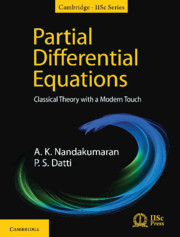Book contents
- Frontmatter
- Dedication
- Contents
- List of Illustrations
- Preface
- Acknowledgments
- Notations
- Chapter 1 Introduction
- Chapter 2 Preliminaries
- Chapter 3 First-Order Partial Differential Equations: Method of Characteristics
- Chapter 4 Hamilton–Jacobi Equation
- Chapter 5 Conservation Laws
- Chapter 6 Classification of Second-Order Equations
- Chapter 7 Laplace and Poisson Equations
- Chapter 8 Heat Equation
- Chapter 9 One-Dimensional Wave Equation
- Chapter 10 Wave Equation in Higher Dimensions
- Chapter 11 Cauchy–Kovalevsky Theorem and Its Generalization
- Chapter 12 A Peep into Weak Derivatives, Sobolev Spaces and Weak Formulation
- References
- Index
Chapter 6 - Classification of Second-Order Equations
Published online by Cambridge University Press: 20 May 2020
- Frontmatter
- Dedication
- Contents
- List of Illustrations
- Preface
- Acknowledgments
- Notations
- Chapter 1 Introduction
- Chapter 2 Preliminaries
- Chapter 3 First-Order Partial Differential Equations: Method of Characteristics
- Chapter 4 Hamilton–Jacobi Equation
- Chapter 5 Conservation Laws
- Chapter 6 Classification of Second-Order Equations
- Chapter 7 Laplace and Poisson Equations
- Chapter 8 Heat Equation
- Chapter 9 One-Dimensional Wave Equation
- Chapter 10 Wave Equation in Higher Dimensions
- Chapter 11 Cauchy–Kovalevsky Theorem and Its Generalization
- Chapter 12 A Peep into Weak Derivatives, Sobolev Spaces and Weak Formulation
- References
- Index
Summary
INTRODUCTION
In this chapter, we discuss the classification of partial differentialequations (PDE), concentrating mostly on linear equations or equations withlinear principal part. In the modern theory of the subject, especially sincethe middle of the last century, the question of classification has takenaltogether new directions, which we only mention very briefly in the sectionon Notes. Also, the classification of PDEs is in general not complete. Thesecond-order equations in two variables have a fairly completeclassification, which is our main topic of discussion in this chapter. Webegin by a discussion on a Cauchy problem for a second-order linear PDE andhighlighting certain subtle differences with a Cauchy problem for anordinary differential equation (ODE). This naturally motivates towards thestudy of the classification of PDE. The general references for this chapterare Courant and Hilbert (1989), Rubinstein and Rubinstein (1998), Koshlyakovet al. (1964), John (1978), Mikhailov (1978), Ladyzhenskaya (1985), McOwen(2005), Renardy and Rogers (2004), Prasad and Ravindran (1996), Vladimirov(1979, 1984), and Hörmander (1976, 1984), among many others.
CAUCHY PROBLEM
We begin by describing a Cauchy problem or aninitial value problem (IVP) for a linear PDE andcomparing it with an IVP associated to a linear ODE. For simplicity of theexposition, we consider the second-order linear equation in a regionΩ in ℝn:
where the coefficients aij; ai; a andthe function f are given real (smooth) valued functionsdefined in Ω. The Cauchy problem for a second-order linear ODE
where the coefficients b; c and the functiong are smooth functions defined in an interval inℝ, consists in finding a solution u satisfying theinitial conditions and for somex0 and arbitraryu0, u1.
A Cauchy problem (or an IVP) associated with the PDE (6.1), in which initialconditions for u and its normal derivative are assigned onan (n − 1)-dimensional surface Γ in Ω.We will see that, in general, this may lead to a lack of existence oruniqueness depending on the nature of Γ.
- Type
- Chapter
- Information
- Partial Differential EquationsClassical Theory with a Modern Touch, pp. 145 - 165Publisher: Cambridge University PressPrint publication year: 2020

